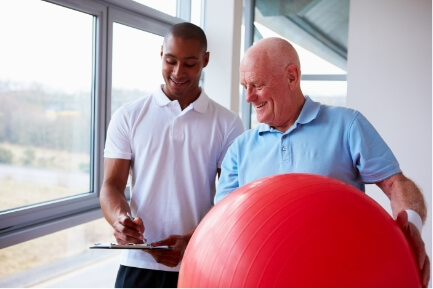Have you ever wondered why some people can effortlessly lift heavy objects while others struggle? The secret lies in understanding the difference between shoulder abduction and adduction. These two movements, which involve the adductor muscles and abductors, are vital for a wide range of activities, from reaching for a high shelf to throwing a ball with precision.
Shoulder abduction involves moving the arm away from the body’s midline, while adduction brings it closer. Picture yourself lifting a dumbbell: as you raise your arm outwards, that’s abduction; when you lower it back down, that’s adduction. These opposing actions work together to give us the full range of motion needed for everyday tasks. The abductors and adductors muscles, along with the rotator cuff, are responsible for these movements.
Mastering shoulder abduction and adduction, as well as lateral raise, is crucial for exercise and rehabilitation programs. Whether you’re aiming to build strength with bench press or recover from an injury, understanding how these movements function can help tailor your workouts accordingly. So next time someone challenges you to try lifting something heavy, make sure your shoulder and hips game falls nothing short of amazing!
We’ll delve into the starting positions of lateral raises and hip abductions, explore their resistance training benefits for the shoulders and legs, and even debunk online attacks on their effectiveness. Get ready to unlock the secrets behind these fundamental shoulder movements!
Understanding the Importance of Shoulder Abduction and Adduction
Shoulder abduction and adduction, also known as lateral raise, are two crucial movements that play a vital role in maintaining a wide range of motion in the shoulder joint. These movements are not only essential for day-to-day activities but also contribute significantly to upper body strength and stability during various exercises involving the torso, legs, and anatomical position.
Proper shoulder abduction in the anatomical position allows you to lift your arm away from your torso, while adduction brings it back towards the midline. These actions involve multiple muscles on the right side working together harmoniously to achieve smooth and controlled movement.
One of the key benefits of shoulder abduction and adduction is their ability to stabilize the shoulder joint in the anatomical position. When performing upper body exercises such as bench presses or push-ups, proper shoulder stabilization on the right side is crucial for preventing injuries and optimizing performance. Neglecting these movements can lead to muscle imbalances, limited mobility, and an increased risk of hip injury.
Moreover, incorporating shoulder abduction and adduction exercises into your fitness routine can greatly improve your posture in the anatomical position. Many individuals spend long hours sitting at desks or engaging in activities that promote rounded shoulders. By focusing on these movements, you can counteract this forward-rounded posture by strengthening the muscles responsible for pulling the shoulders back into alignment, particularly on the right side.
Enhancing your shoulder abduction and adduction capabilities contributes to overall upper body strength, including the side, hip, right, lunge. These movements engage several major muscle groups including the deltoids, pectoralis major, trapezius, rhomboids, and latissimus dorsi. Strengthening these muscles not only improves aesthetics but also enhances functional abilities such as lifting objects overhead or reaching behind your back.
To target shoulder abduction specifically, consider incorporating exercises such as lateral raises or cable side raises into your workout routine. For adduction-focused exercises, try bent-over rows or cable chest flies. Adding variety through different exercise options will help ensure balanced development across all muscle groups involved in these movements. Additionally, to work the right shoulder, try incorporating right lunges into your routine. For the left shoulder, try left lunges.

Differences Between Shoulder Abduction and Adduction
Shoulder abduction and adduction are two distinct movements that play a crucial role in the mobility and functionality of the shoulder joint. Understanding the differences between these movements is essential for targeting specific muscle groups during workouts or rehabilitation exercises. Whether you’re doing a right or left lunge, it’s important to know how these movements affect your shoulders.
Shoulder Abduction
Shoulder abduction, also known as moving the arm away from the body’s midline, engages muscles like deltoids, supraspinatus, and serratus anterior. The deltoids are primarily responsible for initiating and controlling abduction. The supraspinatus muscle stabilizes the joint during this movement, while the serratus anterior aids in protracting and rotating the scapula.
During shoulder abduction exercises, it is important to maintain proper form to prevent injury. Some effective exercises to adduct the shoulder and move it in the right direction include.
- Dumbbell Lateral Raises: Stand with your feet shoulder-width apart, holding a dumbbell in each hand at your sides. Slowly raise your arms out to your sides until they are parallel to the floor, engaging in a hip abduction move.
- Cable Lateral Raises with Shoulder Abduction Pillow: Attach a handle to a cable machine at waist height. Stand sideways with one foot forward and grasp the handle with one hand. Pull your arm upward and outward until it is parallel to the floor to alleviate shoulder abduction pain and prevent shoulder impingement.
- Resistance Band Pull-Aparts: To perform this exercise, hold a resistance band in front of you with both hands at shoulder width apart. Keeping your arms straight but slightly bent at the elbows, pull the band apart by squeezing your shoulder blades together. This move targets your upper back and shoulders.
Shoulder Adduction
In contrast, shoulder adduction involves bringing the arm back towards the body’s midline after being abducted or moved away from it. This movement activates muscles such as pectoralis major, latissimus dorsi, teres major, and rhomboids.
The pectoralis major muscle plays a significant role in adduction as it pulls the arm across the body. The latissimus dorsi, located in the back, assists in this movement by extending and adducting the arm. The teres major muscle also aids in adduction, working synergistically with the latissimus dorsi. Finally, the rhomboids help stabilize and retract the scapula during shoulder adduction.
To target shoulder impingement and alleviate shoulder abduction pain during workouts or rehabilitation exercises, consider incorporating the following exercises with a shoulder abduction pillow to help move the affected muscles.
- Dumbbell Chest Press for Shoulder Impingement: Lie on a bench with a dumbbell in each hand at chest level. Push the dumbbells upward until your arms are fully extended. Use a shoulder abduction pillow if you experience shoulder abduction pain.
- Lat Pulldowns: Sit at a cable machine with an overhead bar attachment. Grasp the bar with your hands wider than shoulder-width apart and pull it down towards your chest.
- Seated Cable Rows: Sit facing a cable machine with your feet placed on footrests and knees slightly bent. Grab the handles with an overhand grip and pull them towards your abdomen while keeping your back straight.
By understanding these differences between shoulder abduction and adduction, you can effectively target specific muscle groups during exercise routines or rehabilitation programs. Incorporating a variety of exercises that involve both movements will help promote balanced strength development and improve overall shoulder stability and mobility.
So next time you hit the gym or engage in shoulder-focused activities, remember to include exercises that cater to both abduction and adduction for optimal results!
Muscles Involved in Shoulder Abduction vs Adduction
Shoulder abduction and adduction are essential movements that allow us to perform various daily activities and sports. Understanding the muscles involved in these movements is crucial for developing a balanced and functional shoulder.
Shoulder Abduction:
When we raise our arm away from the body, we are performing shoulder abduction. This movement primarily engages several key muscles:
- Deltoids (middle): The middle deltoid plays a significant role in initiating shoulder abduction. It is responsible for lifting the arm laterally.
- Supraspinatus: Located on the top of the shoulder blade, the supraspinatus assists in initiating abduction and helps stabilize the humeral head within the glenoid cavity.
- Trapezius (upper fibers): The upper fibers of the trapezius help elevate and upwardly rotate the scapula during abduction, providing stability to the shoulder joint.
- Serratus Anterior: This muscle runs along the sides of the ribcage and aids in protracting or pushing forward the scapula during arm elevation.
- Infraspinatus: Situated on the back of the shoulder blade, this muscle externally rotates and stabilizes the humerus during abduction.
Strengthening these muscles through targeted exercises such as lateral raises, overhead presses, and external rotation exercises can enhance overall shoulder stability and function.
Shoulder Adduction:
Shoulder adduction refers to bringing our arms closer to our body’s midline from an abducted position. Key muscles engaged during this movement include:
- Pectoralis Major (Sternal Head): The sternal head of pectoralis major is responsible for adducting or pulling inwardly our arms towards each other across our chest.
- Latissimus Dorsi: Commonly known as “lats,” this large muscle located on either side of our back aids in adducting and extending the arm.
- Teres Major: Situated beneath the latissimus dorsi, the teres major assists in adduction and extension of the shoulder joint.
- Rhomboids (Major/Minor): These muscles lie between the shoulder blades and help retract or squeeze the scapulae together during adduction.
- Levator Scapulae (to some extent): Although primarily responsible for elevating the scapula, the levator scapulae also contributes to shoulder adduction to some degree.
Proper activation of these muscles is crucial for preventing imbalances and maintaining optimal shoulder health. Neglecting these muscle groups can lead to issues such as shoulder abduction pain or limited range of motion.
Implications of Shoulder Abduction and Adduction in Workouts and Body Movements
Shoulder Abduction Exercises: Targeting Deltoids, Improving Shoulder Width, and Enhancing Upper Body Aesthetics
Shoulder abduction exercises play a crucial role in developing well-rounded shoulders, enhancing upper body aesthetics, and improving overall strength. By engaging the deltoid muscles, these exercises help create a broader shoulder appearance, which is highly desirable for many individuals. The deltoids are responsible for lifting the arms away from the body’s midline, making abduction movements essential for their growth.
Incorporating exercises like lateral raises or dumbbell flyes into your workouts can specifically target the deltoids through abduction movements. These exercises involve raising your arms out to the sides against resistance, effectively isolating and strengthening the shoulder muscles. As a result, you’ll not only achieve better shoulder width but also develop more defined deltoid muscles.
Adduction Exercises: Developing Chest Muscles, Improving Posture, and Enhancing Upper Body Strength
While shoulder abduction focuses on widening the shoulders, adduction exercises primarily work on developing chest muscles while providing additional benefits such as improved posture and enhanced upper body strength. Adduction movements involve bringing the arms closer to the midline of your body.
Exercises like bench presses or cable crossovers are excellent examples of adduction movements that engage the pectoral muscles. These exercises require pushing motions where you bring your hands together or towards your centerline against resistance. Besides targeting the chest muscles directly, adduction exercises also engage other upper body muscles like triceps and anterior deltoids.
By incorporating adduction movements into your workouts regularly, you can strengthen your chest muscles while promoting better overall upper body strength. These exercises contribute to maintaining proper posture by counteracting slouching or rounded shoulders.
Importance of Balanced Muscle Development
To ensure optimal shoulder health and functionality during workouts and everyday movements, it is essential to focus on both abduction and adduction exercises. Neglecting either movement can lead to muscle imbalances and potential injuries.
Balanced muscle development around the shoulder joint helps stabilize the joint itself, reducing the risk of strains or sprains. It also aids in maintaining proper posture, which is crucial for overall body alignment and injury prevention.
By incorporating a combination of abduction and adduction exercises into your workout routine, you can achieve balanced muscle development around the shoulder joint. This approach ensures that all muscles involved in shoulder movements are strengthened equally, promoting stability and reducing the likelihood of overuse injuries.
Improved Performance in Sports Activities
In addition to their benefits in workouts, both shoulder abduction and adduction movements contribute to improved performance in various sports activities. These movements are particularly relevant for sports involving throwing, swinging, or lifting motions.
Shoulder abduction exercises strengthen the deltoids responsible for initiating throwing actions by generating power from the shoulders. Similarly, adduction exercises enhance chest strength necessary for swinging motions such as tennis strokes or golf swings.
Athletes who incorporate both abduction and adduction movements into their training routines can experience improved performance due to enhanced upper body strength and stability. The ability to generate power efficiently from the shoulders translates into more forceful throws or swings while minimizing the risk of strain or injury.

Effective Exercises for Shoulder Abduction: Lateral Dumbbell Raises
Lateral dumbbell raises are a popular exercise for targeting shoulder abduction. This exercise involves raising the arms laterally with dumbbells while keeping them parallel to the ground. By performing lateral dumbbell raises with proper form, you can strengthen the muscles involved in shoulder abduction and improve overall shoulder stability.
Lateral raises primarily target the deltoids (middle), supraspinatus, and other muscles involved in shoulder abduction. These muscles play a crucial role in moving the arm away from the body, allowing you to perform various activities such as lifting objects overhead or reaching out to grab something.
To perform lateral dumbbell raises effectively, follow these steps:
- Start by standing tall with your feet shoulder-width apart and holding a dumbbell in each hand.
- Keep your palms facing your thighs and ensure that your core is engaged, de lacey.
- Begin the movement by slowly raising your arms out to the sides until they are parallel to the ground.
- Maintain a slight bend in your elbows throughout the exercise to avoid unnecessary strain on the de lacey joints.
- Pause at the top of the movement for a moment, focusing on contracting your shoulder muscles.
- Slowly lower the weights back down to starting position, controlling the descent.
When performing lateral dumbbell raises, it’s essential to maintain proper form to maximize effectiveness and minimize injury risk. Here are some key tips for executing the de lacey exercise.
- Avoid using momentum or swinging motions during the exercise; instead, focus on controlled movements to ensure proper form and technique.
- Keep your shoulders relaxed and away from your ears throughout the movement.
- Engage your core muscles for stability and balance.
- Use an appropriate weight that challenges you without compromising form, whether you are doing squats, deadlifts, or bench presses. It is important to find the right balance between pushing yourself and maintaining proper technique. By selecting a weight that is suitable for your current fitness level, you can ensure that you are effectively targeting the muscles and avoiding potential injuries. Remember to always prioritize safety and listen to your body’s limits.
In addition to lateral dumbbell raises, there are other exercises that can help strengthen shoulder abduction:
- Shoulder Abduction Pillow Squeeze: Place a small pillow or foam roller between your elbows while standing upright. Squeeze the pillow or foam roller by actively contracting your shoulder muscles, then release. Repeat for several sets.
- Lateral Lunge with Dumbbells: Stand with your feet hip-width apart and hold a dumbbell in each hand. Take a step to the side, lowering into a lunge position while simultaneously raising your arms out to the sides. Return to the starting position and repeat on the other side.
Incorporating these abduction exercises into your workout routine can help improve shoulder strength and stability. Remember to start with lighter weights and gradually increase as you become more comfortable and confident in your form.
So, if you’re looking to target shoulder abduction, lateral dumbbell raises are an effective exercise that can help strengthen the necessary muscles. By incorporating these exercises into your routine, you’ll be well on your way to improving shoulder stability and overall upper body strength.
Effective Exercises for Shoulder Adduction: Overhead Dumbbell Press
The overhead dumbbell press is a highly effective exercise that specifically targets shoulder adduction. This exercise involves pressing dumbbells overhead from a starting position where they rest at ear level. By incorporating overhead dumbbell presses into your workout routine, you can develop the muscles involved in shoulder adduction while promoting proper movement.
One of the key benefits of the overhead dumbbell press is its ability to engage multiple muscles simultaneously. This exercise primarily targets muscles such as the pectoralis major (sternal head), latissimus dorsi, teres major, rhomboids (major/minor), and levator scapulae to some extent. By working these muscles together, you can enhance overall shoulder strength and stability.
To perform an overhead dumbbell press, follow these steps:
- Begin by sitting on a bench with a dumbbell in each hand, palms facing forward. This exercise is great for targeting the de lacey muscles.
- Start with the dumbbells resting at ear level, elbows bent and pointing out to the sides.
- Engage your core and maintain good posture throughout the exercise.
- Press the dumbbells upward until your arms are fully extended above your head.
- Pause briefly at the top before slowly lowering the weights back down to ear level.
When performing this exercise, it’s important to use proper form and technique to maximize its effectiveness and minimize the risk of injury. Keep these tips in mind:
- Maintain control throughout the movement, avoiding any swinging or jerking motions.
- Focus on using your shoulder muscles to lift and lower the weights rather than relying solely on momentum.
- Keep your core engaged and avoid arching or rounding your back during the exercise.
In addition to traditional dumbbells, you can also incorporate variations of this exercise using resistance bands or other equipment for added challenge or variety in your workouts.
Emphasizing the Significance of Shoulder Abduction and Adduction
In conclusion, understanding the importance of shoulder abduction and adduction is crucial for anyone looking to improve their overall shoulder strength and mobility. These two movements play a vital role in various workouts and body movements, making them essential for achieving optimal fitness goals.
The key differences between shoulder abduction and adduction lie in the direction of movement. Abduction refers to moving the arm away from the body, while adduction involves bringing it back towards the midline. By comprehending these distinctions, individuals can tailor their exercise routines to target specific muscle groups effectively.
Several muscles are involved in shoulder abduction and adduction. For abduction, the primary muscles include the deltoids, supraspinatus, and middle fibers of the trapezius. On the other hand, adduction engages muscles such as the pectoralis major, latissimus dorsi, and teres major. Strengthening these muscles through targeted exercises can greatly enhance overall shoulder stability.
Understanding how shoulder abduction and adduction impact performance is essential. Whether you’re an athlete aiming to improve throwing accuracy or someone seeking better posture during everyday activities, incorporating exercises that emphasize these movements can yield significant improvements.
For effective exercises targeting shoulder abduction specifically, lateral dumbbell raises are highly recommended. This exercise involves lifting dumbbells outwards from your sides until they reach shoulder height. It helps strengthen the deltoids while improving stability in this range of motion.
Similarly, overhead dumbbell presses are excellent for working on shoulder adduction. This exercise requires pressing dumbbells upwards from a starting position at ear level until your arms are fully extended overhead. It targets various muscles involved in adduction while promoting upper body strength.
To take full advantage of these exercises and maximize results with both shoulder abduction and adduction training, consistency is key. Incorporate them into your regular workout routine and gradually increase the weights as your strength improves. Remember to maintain proper form and listen to your body to avoid injury.
In conclusion, shoulder abduction and adduction are vital movements that contribute significantly to overall shoulder strength and mobility. By understanding their importance, differences, muscles involved, and implications in workouts and body movements, you can make informed decisions about incorporating exercises that target these motions into your fitness routine. So start working on improving your shoulder abduction and adduction today for stronger, more functional shoulders.
FAQs
1. What is the difference between shoulder abduction and adduction?
Shoulder abduction involves moving the arm away from the body, while adduction brings it back towards the midline.
2. Which muscles are involved in shoulder abduction?
The primary muscles involved in shoulder abduction include the deltoids, supraspinatus, and middle fibers of the trapezius.
3. What are some effective exercises for shoulder abduction?
Lateral dumbbell raises are an excellent exercise for targeting shoulder abduction. They involve lifting dumbbells outwards from your sides until they reach shoulder height.
4. What is the significance of shoulder adduction in workouts?
Shoulder adduction plays a crucial role in various workouts by engaging muscles such as the pectoralis major, latissimus dorsi, and teres major. It contributes to overall upper body strength and stability.
5. How can I strengthen my shoulders through adduction exercises?
Overhead dumbbell presses are highly effective for strengthening shoulder adduction. This exercise requires pressing dumbbells upwards from ear level until your arms are fully extended overhead.
6. Can improving shoulder abduction and adduction benefit everyday activities?
Yes! Enhancing these movements can greatly improve posture during everyday activities like carrying groceries or reaching for objects on high shelves.
7. How often should I incorporate exercises targeting shoulder abduction and adduction?
Consistency is key. Aim to incorporate these exercises into your regular workout routine at least two to three times a week for optimal results.




